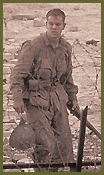Cinematographer Janusz Kaminski, ASC and his crack camera team re-enlist with director Steven Spielberg for SAVING PRIVATE RYAN.
On June 6, 1944, approximately 2,500 American soldiers were killed while storming Omaha Beach on the Normandy coast, as dug-in German defenders assailed the intrepid troops with a barrage of artillery fire from heavy fortifications. "Operation Overlord," the invasion of Europe, had begun, and the bloody event known as D-Day proved to be the turning point of World War II, signaling the beginning of the end for Nazi Germany.
Director Steven Spielberg has revisited this narrative-rich era a number of times during his career, alternately exploring the dramatic, adventurous, tragic, and even humorous aspects of the age. The filmmaker’s latest effort, Saving Private Ryan, teamed him for a fourth time with cinematographer Janusz Kaminski, ASC, who earned Academy, BAFTA and ASC Awards for the stark black-and-white photography he lent to Schindler’s List (see AC Jan. 1994). Kaminski has since shot Spielberg’s subsequent films, The Lost World (AC June ’97) and Amistad (AC Jan. ’98). The latter earned the cameraman both Academy and ASC Award nominations.
Opening with the most graphic and elaborate film depiction of D-Day to date, the $65 million Private Ryan uses this monumental event as a springboard for its story. Loosely based upon actual WWII cases of families losing four or five sons in battle, the picture follows Captain John Miller (Tom Hanks) as he leads an eight-man squad behind enemy lines and into France to search for the last surviving Ryan brother (Matt Damon), whose three siblings have been reported killed in action. As the squad advances into greater and greater peril, its members who include Sergeant Horvath (Tom Sizemore), Corporal Upham (Jeremy Davies), Medic Wade (Giovanni Ribisi) and Privates Reiben (Edward Burns), Caparzo (Vin Diesel), Mellish (Adam Goldberg) and Jackson (Barry Pepper) begin to question the military’s decision to risk eight lives in the hope of saving just one.
Boot camp
After enlisting his principal cast members, Spielberg enrolled the actors in a grueling training course with military advisor and retired Marine Captain Dale Dye, who has lent his expertise to such diverse projects as Platoon, The Last of the Mohicans, Forrest Gump and Starship Troopers. For 10 full days, the group was subjected to a strict military regimen of pre-dawn reveille, five-mile runs, weapons training and military exercises, while getting no more than three hours of sleep a night under a soggy blanket. When their ordeal finally ended, the haggard-looking actors were primed and ready to simulate combat on film.
"We didn’t have to shoot much in terms of makeup tests," says Kaminski with a wry laugh. "After their experience in boot camp, the actors were all pretty much beaten up. Saving Private Ryan was a physically demanding movie, because their backpacks were full and the guns were real and quite heavy. After two weeks of shooting, we didn’t need any aging makeup they all had dark circles under their eyes!"
Going to war
Saving Private Ryan’s intended preproduction period was severely truncated when Spielberg decided to shoot Amistad after completing The Lost World and before beginning work on the WWII epic. Nevertheless, Kaminski spent two weeks doing camera tests in Los Angeles prior to leaving for England, where most of Ryan would be shot.
Kaminski notes that it’s during these test periods that he determines the look of a film. "When I read a script and like the story, I respond to it on an emotional level," says the cinematographer. "I have a concept of who the characters are and where the story is taking us, and I then imagine how I can enhance the storytelling through visuals. The story automatically dictates how I’m going to light it. That may sound simple, but it’s not, because it’s my personal interpretation of a script that allows me to create the visuals. That interpretation is based on my own life experiences, aesthetics, education, and knowledge, all of which help to shape my understanding of a story.
"In a funny way, I previsualize my work by cancellation. For instance, I may cancel out other movies that I don’t want a particular picture to look like. I may not have known exactly how I wanted Saving Private Ryan to look, but I knew I didn’t want it to look like The Lost World, which had hard light and contrast. By eliminating certain visual styles, I narrow down the concept for the film I’m working on. I then do a lot of research, looking through books and paintings and watching other movies. I think of certain color schemes, compositions and camera moves that I’d like to use in the film, and all of those choices result from what the written material dictates.
"Later on in prep, I start doing tests to figure out how to achieve the appropriate visual style by applying various camera techniques. For example, even though Private Ryan is not necessarily a true story, it’s set in a very realistic scenario. We’re all familiar with World War II and the invasion of Normandy, so there were certain historical realities that I had to fulfill. And obviously, a lot of our knowledge of that war comes from footage shot by the combat photographers or from very masterfully staged films, such as the Nazi propaganda films of Leni Riefenstahl."
[ continued on page 2 ]
